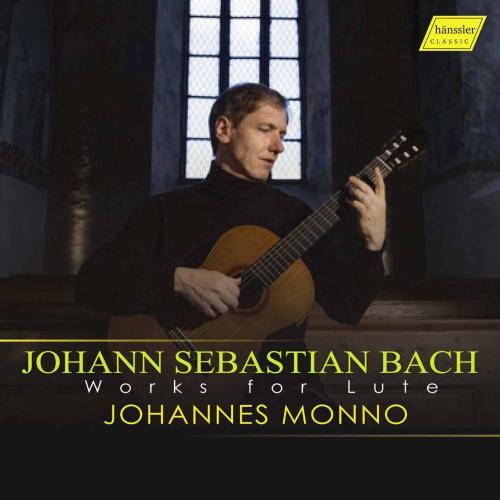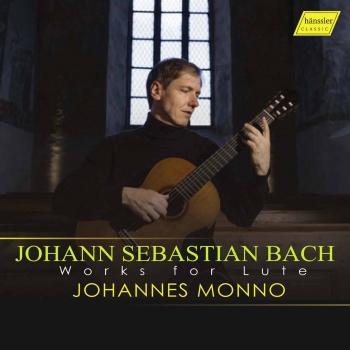
J.S. Bach: Works for Lute Johannes Monno
Album Info
Album Veröffentlichung:
2017
HRA-Veröffentlichung:
04.03.2017
Label: haenssler CLASSIC
Genre: Classical
Subgenre: Inst
Interpret: Johannes Monno
Komponist: Johann Sebastian Bach (1685 - 1750)
Das Album enthält Albumcover
- Johann Sebastian Bach (1685 - 1750): Lute Suite in G Minor, BWV 995 (Arr. for Guitar):
- 1 Lute Suite in G Minor, BWV 995 (Arr. for Guitar): I. Prelude 05:37
- 2 Lute Suite in G Minor, BWV 995 (Arr. for Guitar): II. Allemande 05:50
- 3 Lute Suite in G Minor, BWV 995 (Arr. for Guitar): III. Courante 02:11
- 4 Lute Suite in G Minor, BWV 995 (Arr. for Guitar): IV. Sarabande 03:08
- 5 Lute Suite in G Minor, BWV 995 (Arr. for Guitar): V. Gavotte I - II 04:41
- 6 Lute Suite in G Minor, BWV 995 (Arr. for Guitar): VI. Gigue 02:24
- Lute Partita in C Minor, BWV 997 (Arr. for Guitar):
- 7 Lute Partita in C Minor, BWV 997 (Arr. for Guitar): I. Prelude 03:22
- 8 Lute Partita in C Minor, BWV 997 (Arr. for Guitar): II. Fugue 07:11
- 9 Lute Partita in C Minor, BWV 997 (Arr. for Guitar): III. Sarabande 05:18
- 10 Lute Partita in C Minor, BWV 997 (Arr. for Guitar): IV. Gigue - V. Double 04:21
- Prelude in C Minor, BWV 999 (arr. for guitar):
- 11 Prelude in C Minor, BWV 999 (arr. for guitar) 01:44
- Fugue in G Minor, BWV 1000 (arr. for guitar):
- 12 Fugue in G Minor, BWV 1000 (arr. for guitar) 05:15
- Prélude, Fugue & Allegro in E-Flat Major, BWV 998 (Arr. for Guitar):
- 13 Prélude, Fugue & Allegro in E-Flat Major, BWV 998 (Arr. for Guitar): I. Prélude 02:45
- 14 Prélude, Fugue & Allegro in E-Flat Major, BWV 998 (Arr. for Guitar): II. Fugue 06:20
- 15 Prélude, Fugue & Allegro in E-Flat Major, BWV 998 (Arr. for Guitar): III. Allegro 03:24
- Lute Suite in E Minor, BWV 996 (Arr. for Guitar):
- 16 Lute Suite in E Minor, BWV 996 (Arr. for Guitar): I. Prelude 02:50
- 17 Lute Suite in E Minor, BWV 996 (Arr. for Guitar): II. Allemande 02:42
- 18 Lute Suite in E Minor, BWV 996 (Arr. for Guitar): III. Courante 02:31
- 19 Lute Suite in E Minor, BWV 996 (Arr. for Guitar): IV. Sarabande 04:20
- 20 Lute Suite in E Minor, BWV 996 (Arr. for Guitar): V. Bourrée 01:26
- 21 Lute Suite in E Minor, BWV 996 (Arr. for Guitar): VI. Gigue 03:13
- Lute Partita in E Major, BWV 1006a (Arr. for Guitar):
- 22 Lute Partita in E Major, BWV 1006a (Arr. for Guitar): I. Preludio 03:58
- 23 Lute Partita in E Major, BWV 1006a (Arr. for Guitar): II. Loure 03:25
- 24 Lute Partita in E Major, BWV 1006a (Arr. for Guitar): III. Gavotte en rondeau 03:23
- 25 Lute Partita in E Major, BWV 1006a (Arr. for Guitar): IV. Menuett I-II 04:36
- 26 Lute Partita in E Major, BWV 1006a (Arr. for Guitar): V. Bourrée 01:47
- 27 Lute Partita in E Major, BWV 1006a (Arr. for Guitar): VI. Gigue 02:11
Info zu J.S. Bach: Works for Lute
The lute was a very popular instrument in Bach’s day. The various types of lute had for centuries been influential in shaping the development of music. Certain musical terms are in fact directly derived from lute-playing technique, including the expression style brise, coined by Couperin to denote lute-like arpeggiated chords on the harpsichord. During the first half of the 18th century, Sylvius Leopold Weiss was particularly renowned and respected for his consummate mastery of the lute. In his treatise of 1727 on the theory and practice of playing the lute, Ernst Gottlieb Baron writes: “He has been the first to show that more could be done on the lute than was hitherto thought possible…” Reporting on a meeting between S.L. Weiss and J.S. Bach in 1739, Johann Elias Bach wrote the following in a letter to his pupil Johann Wilhelm Koch: “…we heard some very fine music when my cousin from Dresden, who came to stay for four weeks, gave several performances in our house together with the two famous lute-players Herr Weiss and Herr Kropfgans.” This musical acquaintance is likely to have begun much earlier, namely during J.S. Bach’s time in Cothen. Up until this point it was customary for lute music to be composed only by lutenists- too great were the difficulties in coming to grips with the instrument’s tuning, its illogical limitations on polyphonic part-writing and its unique form of notation, known as tablature.
Johannes Monno, lute, classical guitar
Johannes Monno
entdeckte mit sechs Jahren die Liebe zur Gitarre. Schon früh faszinierte ihn die Geschichte und Entwicklung des Instruments. Die stimmige Verbindung von künstlerischer, wissenschaftlicher und pädagogischer Arbeit stellt daher für ihn ein zentrales Anliegen dar. Eingehend erforschte er die Geschichte und Spielweise von Vihuela da Mano, Barockgitarre und Chitarrone - etliche Publikationen, CD´s, Vortragsreihen und Rundfunkaufnahmen resultieren aus dieser Beschäftigung.
Sein klangliches Ideal fand er in den Gitarren von Matthias Dammann, dessen Instrumente er bereits seit 1984 spielt.
Neben der kammermusikalischen Zusammenarbeit mit Künstlern wie Wilfried Jochens, Ingo Goritzki, Olaf Van Gonnissen, Thomas Müller Pering, Kolja Lessing und dem Ensemble Rilegato, hat Johannes Monno in den letzten Jahren auch immer wieder durch thematisch fein gestaltete Soloprogramme auf sich aufmerksam gemacht. Von Kritikern wird immer wieder die enorme Intensität und Farbigkeit seiner Interpretationen sowie die stilistische Souveränität hervorgehoben.
Als ehemaliger DAAD-Stipendiat erhielt er zunächst Unterricht bei Michael Simon und bei Wilfried Halter. Von 1989–1990 studierte er bei José Tomas in Alicante (Spanien). Anschließend setzte er sein Studium an der Kölner Musikhochschule bei Hubert Käppel und Konrad Junghänel fort, der ihn über sechs Jahre entscheidend inspirierte und prägte.
Früh erfolgte der Ruf an die Hochschule für Musik und Theater in Hamburg, wo er neben dem künstlerischen Hauptfach die Methodik und Didaktik des Instruments unterrichtete. Eine Lehrverpflichtung für Geschichte der Gitarre und Continuospiel für Gitarristen an der Hochschule für Musik und Darstellende Kunst in Frankfurt schloss sich an. Seit 2004 ist Johannes Monno Professor an der Hochschule für Musik und Darstellende Kunst in Stuttgart. Dort betreut er eine äußerst erfolgreiche Gitarrenklasse mit etlichen internationalen Preisträgern und unterrichtet das Seminar ´Geschichte der Gitarre´.
Johannes Monno ist neben Thomas Müller-Pering und Olaf Van Gonnissen Herausgeber der Neuen Karl Scheit-Reihe bei UE und Künstlerischer Leiter des SICG-Festivals.
“The guitar players and fans would like to have the possibility to appreciate the way Johannes Monno works with music more often. It is not the pursuit of the superficial effects nor the purposeless virtuosity. Either in Bach’s sonata or in Spanish music of the 20th century – each tone has its meaning and place in Monno’s interpretation.“ (Konrad Junghänel)
In his life, Johannes Monno is trying to achieve a balanced combination of artistic, scientific and pedagogical work. He intensively cooperates with the artists like Kolja Lessing, Wilfried Jochens, Ingo Goritzki or Olaf Van Gonnisen and meanwhile devotes his time and energy to the ensemble Rilegato, which he co-founded with a charango player Diego Jascalevich. As a soloist he regularly gives performances in his country and abroad. He has released 3 Solo-CDs so far and has taken part in various chamber ensemble recordings. If the time allows him to, he likes to perform as a continuo player.
His pedagogical career started at the Academy of Music in Hamburg where he used to teach guitar interpretation, methodics and didactics. Next he was teaching guitar history and continuo interpretation for guitarists at the Academy of Music in Frankfurt. In 2004 Johannes Monno was appointed Professor at the Music Academy in Stuttgart where he leads a very succesfull guitar department and teaches guitar history.
Dieses Album enthält kein Booklet







